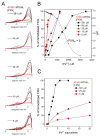Effects of Fe2+/Fe3+ Binding to Human Frataxin and Its D122Y Variant, as Revealed by Site-Directed Spin Labeling (SDSL) EPR Complemented by Fluorescence and Circular Dichroism Spectroscopies
- PMID: 33348670
- PMCID: PMC7766144
- DOI: 10.3390/ijms21249619
Effects of Fe2+/Fe3+ Binding to Human Frataxin and Its D122Y Variant, as Revealed by Site-Directed Spin Labeling (SDSL) EPR Complemented by Fluorescence and Circular Dichroism Spectroscopies
Abstract
Frataxin is a highly conserved protein whose deficiency results in the neurodegenerative disease Friederich's ataxia. Frataxin's actual physiological function has been debated for a long time without reaching a general agreement; however, it is commonly accepted that the protein is involved in the biosynthetic iron-sulphur cluster (ISC) machinery, and several authors have pointed out that it also participates in iron homeostasis. In this work, we use site-directed spin labeling coupled to electron paramagnetic resonance (SDSL EPR) to add new information on the effects of ferric and ferrous iron binding on the properties of human frataxin in vitro. Using SDSL EPR and relating the results to fluorescence experiments commonly performed to study iron binding to FXN, we produced evidence that ferric iron causes reversible aggregation without preferred interfaces in a concentration-dependent fashion, starting at relatively low concentrations (micromolar range), whereas ferrous iron binds without inducing aggregation. Moreover, our experiments show that the ferrous binding does not lead to changes of protein conformation. The data reported in this study reveal that the currently reported binding stoichiometries should be taken with caution. The use of a spin label resistant to reduction, as well as the comparison of the binding effect of Fe2+ in wild type and in the pathological D122Y variant of frataxin, allowed us to characterize the Fe2+ binding properties of different protein sites and highlight the effect of the D122Y substitution on the surrounding residues. We suggest that both Fe2+ and Fe3+ might play a relevant role in the context of the proposed FXN physiological functions.
Keywords: CD; EPR; Fe-S cluster assembly machinery; fluorescence; frataxin; iron.
Conflict of interest statement
The authors declare no conflict of interest.
Figures









Similar articles
-
A Combined Spectroscopic and In Silico Approach to Evaluate the Interaction of Human Frataxin with Mitochondrial Superoxide Dismutase.Biomedicines. 2021 Nov 25;9(12):1763. doi: 10.3390/biomedicines9121763. Biomedicines. 2021. PMID: 34944579 Free PMC article.
-
Exploring iron-binding to human frataxin and to selected Friedreich ataxia mutants by means of NMR and EPR spectroscopies.Biochim Biophys Acta Proteins Proteom. 2019 Nov;1867(11):140254. doi: 10.1016/j.bbapap.2019.07.007. Epub 2019 Jul 22. Biochim Biophys Acta Proteins Proteom. 2019. PMID: 31344531
-
Monomeric yeast frataxin is an iron-binding protein.Biochemistry. 2006 Jun 27;45(25):7767-77. doi: 10.1021/bi060424r. Biochemistry. 2006. PMID: 16784228 Free PMC article.
-
Elucidating the design principles of photosynthetic electron-transfer proteins by site-directed spin labeling EPR spectroscopy.Biochim Biophys Acta. 2016 May;1857(5):548-556. doi: 10.1016/j.bbabio.2015.08.009. Epub 2015 Sep 1. Biochim Biophys Acta. 2016. PMID: 26334844 Review.
-
Frataxin Structure and Function.Subcell Biochem. 2019;93:393-438. doi: 10.1007/978-3-030-28151-9_13. Subcell Biochem. 2019. PMID: 31939159 Review.
Cited by
-
Correlation of salivary cytokine IL-17A and 1,25 dihydroxycholecalciferol in patients undergoing orthodontic treatment.Odontology. 2024 Jul;112(3):966-975. doi: 10.1007/s10266-023-00890-1. Epub 2024 Feb 6. Odontology. 2024. PMID: 38319548
-
Searching for Frataxin Function: Exploring the Analogy with Nqo15, the Frataxin-like Protein of Respiratory Complex I from Thermus thermophilus.Int J Mol Sci. 2024 Feb 5;25(3):1912. doi: 10.3390/ijms25031912. Int J Mol Sci. 2024. PMID: 38339189 Free PMC article.
-
A Combined Spectroscopic and In Silico Approach to Evaluate the Interaction of Human Frataxin with Mitochondrial Superoxide Dismutase.Biomedicines. 2021 Nov 25;9(12):1763. doi: 10.3390/biomedicines9121763. Biomedicines. 2021. PMID: 34944579 Free PMC article.
-
Molecular Details of the Frataxin-Scaffold Interaction during Mitochondrial Fe-S Cluster Assembly.Int J Mol Sci. 2021 Jun 2;22(11):6006. doi: 10.3390/ijms22116006. Int J Mol Sci. 2021. PMID: 34199378 Free PMC article. Review.
-
Human frataxin, the Friedreich ataxia deficient protein, interacts with mitochondrial respiratory chain.Cell Death Dis. 2023 Dec 8;14(12):805. doi: 10.1038/s41419-023-06320-y. Cell Death Dis. 2023. PMID: 38062036 Free PMC article.
References
-
- Campuzano V., Montermini L., Molto M.D., Pianese L., Cossee M., Cavalcanti F., Monros E., Rodius F., Duclos F., Monticelli A., et al. Friedreich’s Ataxia: Autosomal Recessive Disease Caused by an Intronic GAA Triplet Repeat Expansion. Science. 1996;271:1423–1427. doi: 10.1126/science.271.5254.1423. - DOI - PubMed
-
- De Castro M., García-Planells J., Monrós E., Cañizares J., Vázquez-Manrique R., Vílchez J.J., Urtasun M., Lucas M., Navarro G., Izquierdo G., et al. Genotype and Phenotype Analysis of Friedreich’s Ataxia Compound Heterozygous Patients. Hum. Genet. 2000;106:86–92. doi: 10.1007/s004399900201. - DOI - PubMed
MeSH terms
Substances
Grants and funding
LinkOut - more resources
Full Text Sources
Medical

